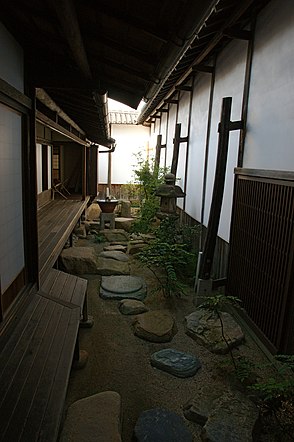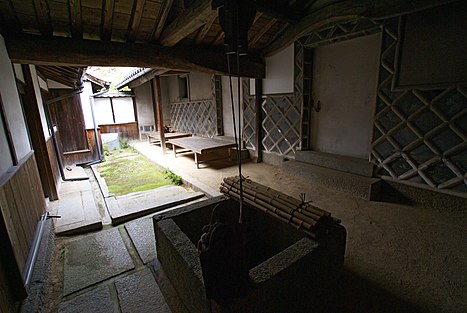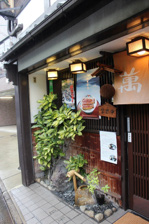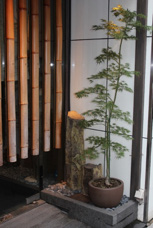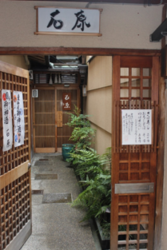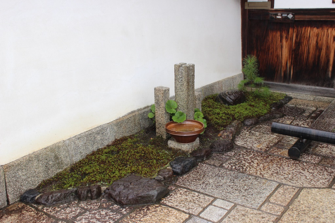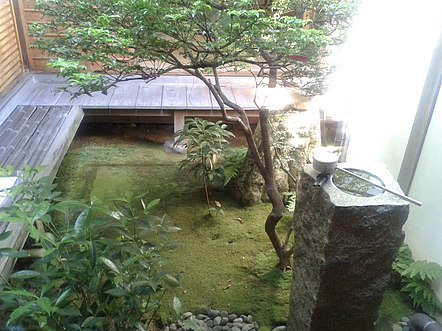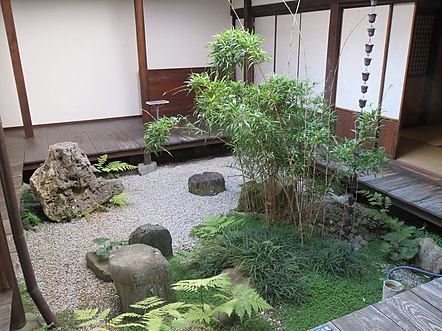Tsubo-niwa
A tsubo-niwa (Kanji: 坪庭 or 壷庭, hiragana: つぼ にわ) is a very small garden.[1] "Niwa" means "garden". Technically, a tsubo (坪) is a unit, about 3.3 square metres (36 sq ft) (the size of a large double bed); however, the other spelling of "tsubo-niwa" translates as "container-garden", and tsubo-niwas may be a bit larger.[1] They have been described as "quasi-indoor gardens".[2]
Courtyard gardens of all sizes were also called naka-niwa , inner gardens.[3] In a machiya, the tōri-niwa (Kanji: 通り庭, passage-garden) includes both the mise-niwa (shop entrance garden) and the hashiri-niwa (hallway-garden, often mostly-roofed and used as a kitchen); zensai-niwa are at the front of the building, and additional tsubo-niwa may be found in the interior and at the rear.[4]
History

These small gardens were originally found in the interior courtyards of Heian period palaces, and were designed to give a glimpse of nature and some privacy to the residents of the rear side of the building. They were as small as one tsubo, or about 3.3 square meters.[5]
During the Edo period, merchants began building small gardens in the space behind their shops, which faced the street, and their residences, located at the rear. These tiny gardens were meant to be seen, not entered. They usually had a stone lantern, a water basin, stepping stones and a few plants, in the cha-niwa (tea[house]-garden) style then fashionable.[5]
Tsubo-niwa became more popular in the early 21st century,[6] and are found in many Japanese residences, hotels, restaurants, and public buildings.[5] Multistory and underground interior spaces present difficulties for tsubo-niwa cultivation; artificial lighting, anidolic lighting (using fiberoptic cables to pipe in sunlight), and a combination of both have been used.[2]
Purpose
Tsubo-niwas are used to provide a touch of nature, connect the outdoors to the indoors, and make an indoor space seem larger.[6] They can act as light wells.[1] Several tsubo-niwas can be used to set up a cross-draft, so that breezes blow through the living space.[6] They may also contain a basin,[1] traditionally used for temizu, hand-cleansing.
They are often set up where they can be seen by home occupants while relaxing or eating dinner.[6] Commercial restaurants and eateries, such as ramen shops, may also have tsubo-niwas, placed so that guests can see them while eating.[9][10]
Tsubo-niwas use less space than larger gardens and are cheaper to build. As of 2012, the cost is in the low hundred thousand yen (low thousands of US dollars) for professional installation. Do-it-yourself kits cost a tenth as much and upwards.[6] They also take less time to maintain; keeping a traditional Japanese garden is considered a meditative act.[1]
Contents
Tsubo-niwas typically contain a functional tōrō (lantern) and a chōzu-bachi (water basin), such as a tsukubai. They may also contain sculpture. Much of the area may be filled with gravel, set with larger stones, and carefully raked and kept free of weeds. Plantings may be very minimal, and surrounded by stones,[1] or the whole area may be covered with vegetation. Shade-loving plants are needed, as a narrow courtyard will seldom be in direct sunlight (moss, for instance). Dwarf plants may be used.[11] A few stems of bamboo are common, but not ubiquitous.[1] Artificial plants are also sometimes used.[6]
Famous tsubo-niwas
.jpg)
A good example from the Meiji period is found in the villa of Murin-an in Kyoto.[12] Totekiko is a famous courtyard rock garden.[13]
References
| Wikimedia Commons has media related to Tsubo-niwa. |
| Wikimedia Commons has media related to Naka-niwa (courtyard gardens, regardless of size). |
| Wikimedia Commons has media related to Mise-niwa (shop-entrance garden). |
- Keane, Marc P. (18 April 2016). "Japanese Courtyard Gardens". Kyoto Journal.
- Arimoto, Y.; Homma, Y.; Furuune, H.; Tanaka, K.; Yokota, J.; Hara, K. (March 1995). "Indoor gardens using the Himawari sunlight collection and transmission device". Acta Horticulturae (391): 103–110. doi:10.17660/ActaHortic.1995.391.8.
- Mansfield, Stephen. "Mirei Shigemori: at home with stone". Japan Times.
- "Kyomachiya townhouses are full of interesting features!". Why KYOTO? Magazine. Leaf Publications Co. Ltd. 21 March 2017. Retrieved 8 July 2020.
- Young, The Art of the Japanese Garden, p. 126
- Tanikawa, Miki (23 August 2012). "From Japan's Urban Dwellings, Corners of Serenity". The New York Times.
- Feuerpeil, Jenny (30 June 2014). "Day 89 – Kyoto has a new garden". 90 Days in Kyoto.
- Feuerpeil, Jenny (26 August 2019). "The Tiniest Garden – Web Comic". 90 Days in Kyoto.
- Account: [7] Sketches: [8]
- "Muza-chan's Gate to Japan". muza-chan.net.
- Judy Kilpatrick. "How to Plan a Japanese Courtyard Garden". SFGATE.
- Gunter Nitschke, Le jardin japonais, p. 225.
- "Ryogen-in, a sub-temple of Daitoku-ji". kyoto.asanoxn.com.
